Every organization faces the challenge of turning mountains of data into meaningful action. Generic AI can feel like a distant promise, powerful in theory, but often missing the mark when applied to the specific realities of your industry.
Imagine a model trained not on all the data in the world, but on the precise knowledge, terminology, and nuances of your domain, whether it’s retail’s product catalogs and inventory details, manufacturing’s intricate processes, or the complex logistics of supply chains.
Domain-specific large language models (LLMs) transform this vision into reality. They don’t just serve executives making strategic decisions, they empower employees across all levels to work smarter, automate repetitive tasks, and generate insights that are immediately relevant. By speaking your business’s language, these models bridge the gap between overwhelming information and meaningful action, creating a seamless collaboration between humans and AI.
More than just technology, domain-specific LLMs are strategic allies. They cut through complexity, enhance operational efficiency, and deliver outcomes that truly matter, helping organizations innovate with confidence and purpose. In this blog, we’ll explore how these models are shaping industries, share practical LLM use cases, outline key challenges, and provide actionable guidance for deploying them effectively so that you can unlock tangible value for your business at every level.
From generic LLMs to domain-specific intelligence
Enterprises face an overwhelming surge of data, yet insight often remains elusive. Generic LLMs can process information at scale, but their outputs lack the contextual understanding needed to guide industry-specific decisions or navigate regulatory and operational complexities.
Domain-specific LLMs bridge this gap, embedding sector knowledge, workflows, and compliance nuances to deliver intelligence that is not only precise but strategically actionable, empowering leaders to make informed decisions, anticipate challenges, and unlock tangible business outcomes.
Understanding domain-specific LLMs
A domain-specific LLM is an AI model meticulously trained and fine-tuned to comprehend the language, data patterns, and workflows unique to a particular industry or business function. Unlike general LLMs that rely on broad, heterogeneous datasets, domain-specific models leverage curated industry data, regulatory frameworks, functional guidelines, and historical operational information.
This training allows the model to interpret complex, unstructured data, recognize sector-specific terminology, and anticipate operational or strategic challenges. By embedding knowledge from relevant case studies, compliance standards, and workflows, the model generates contextual, actionable intelligence that supports decision-making at all levels, from tactical execution to generative enterprise AI strategy.
Across sectors such as retail, manufacturing, and distribution, domain-specific LLMs transform raw data into insights aligned with business objectives, improving efficiency, reducing risk, and uncovering opportunities that generic AI cannot detect. They serve as strategic partners, enabling executives to act decisively and confidently.
How general LLMs Work
General-purpose LLMs are trained on massive, heterogeneous datasets including books, articles, web content, and structured data and use algorithms to identify patterns, generate coherent responses, and synthesize knowledge across topics.
While versatile, these models lack domain-specific depth. They may overlook industry terminology, operational subtleties, or compliance requirements, which can require human validation and slow decision-making. Understanding these limitations is essential when evaluating Gen AI solutions for enterprise adoption.
Why generic LLMs alone aren’t enough
Generic LLMs are powerful in analyzing broad datasets and identifying patterns, but their strength in scale often comes at the cost of precision. They cannot fully grasp industry-specific terminology, regulatory frameworks, or operational workflows, which are critical for making accurate, actionable decisions in complex enterprise environments.
Relying solely on generic models may result in insights that are too broad, misaligned, or require extensive human validation, slowing decision-making and limiting strategic impact. In sectors like retail, manufacturing, and distribution, such gaps can translate into missed opportunities, inefficiencies, and operational risk.
This limitation underscores the need for domain-specific LLMs, which build upon the capabilities of general models but are meticulously fine-tuned with curated industry data, functional workflows, and compliance knowledge. By bridging the gap between generalized AI and practical enterprise intelligence, domain-specific models empower organizations to act confidently, optimize operations, and drive measurable business outcomes.
Why do you need to tailor your LLM to be domain-specific?
A domain-specific large language model (LLM) goes beyond broad, general-purpose language understanding by embedding your industry’s unique data, terminology, and operational nuances. This specialized focus enables precise predictions, relevant future recommendations, and AI-driven insights that support regulatory compliance, operational excellence, and sustainable competitive advantage.
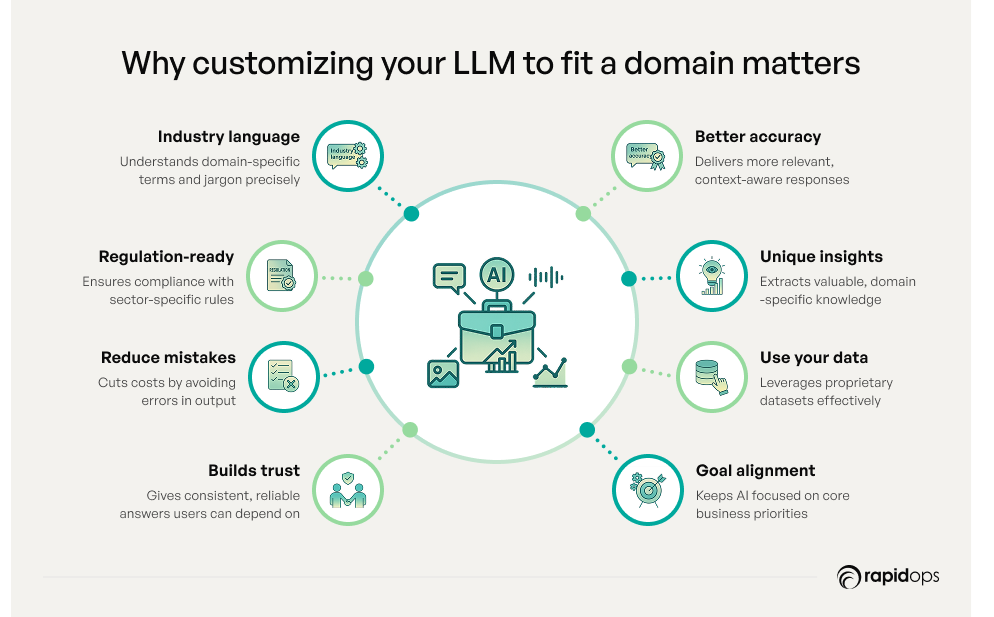
1. Understand industry-specific language with precision
Domain-specific LLMs are trained on carefully curated datasets that capture the unique vocabulary, jargon, and communication styles of particular industries. This targeted training allows the model to accurately interpret complex, domain-specific inputs and generate outputs that resonate with experts. By reducing ambiguity, these models enhance the relevance and clarity of AI interactions across key business functions.
2. Deliver more accurate and context-relevant insights
Focusing on sector-specific data and scenarios empowers domain-specific LLMs to generate insights deeply aligned with real-world operational contexts. This focus ensures that forecasts, recommendations, and analyses are not only precise but also actionable, enabling leaders to make confident, data-driven decisions that directly boost business performance.
3. Reduce costs by minimizing errors and inefficiencies
Domain-specific training significantly cuts down on misunderstandings, irrelevant responses, and the need for human corrections. The result is fewer costly errors, faster processing times, and smoother workflows. These efficiencies translate into tangible cost savings and improved productivity across business units.
4. Build user trust through reliable, consistent responses
Trust is critical for widespread AI adoption. Tailored LLMs deliver dependable, context-aware answers by leveraging deep domain expertise, minimizing mistakes and irrelevant outputs. This reliability fosters stronger confidence among users and stakeholders, accelerating organizational buy-in and enabling scalable AI integration.
5. Unlock hidden domain insights for innovation
Specialized models excel at uncovering subtle patterns and insights buried within proprietary and industry-specific data. These unique discoveries open doors to innovation, operational improvements, and strategic differentiation opportunities that general models may miss.
6. Harness proprietary data as a strategic asset
Incorporating exclusive internal data into domain-specific LLM training transforms proprietary knowledge into a powerful competitive advantage. This approach enhances AI precision and relevance, enabling customized solutions that reflect your organization’s unique capabilities, solutions unattainable with off-the-shelf, generic models.
7. Align AI capabilities with core business goals
Tailoring your LLM ensures AI initiatives directly support your organization’s strategic objectives, key performance indicators, and value drivers. This alignment turns AI from a technical experiment into a vital business tool, delivering measurable outcomes, strengthening competitive positioning, and fueling sustainable growth.
8. Ensure compliance with industry regulations
Many industries face strict regulatory requirements that demand rigorous adherence. Domain-specific LLMs embed these compliance standards into their training, helping organizations proactively identify risks, maintain regulatory controls, and avoid costly penalties. This seamless integration of governance into AI workflows reinforces risk management and operational integrity.
Domain-specific vs general LLM
Selecting the right large language model (LLM) is pivotal for enterprises aiming to harness AI for strategic advantage. Understanding the fundamental differences between domain-specific and general LLMs empowers senior leaders to make informed decisions that maximize ROI, mitigate risks, and align with business goals.
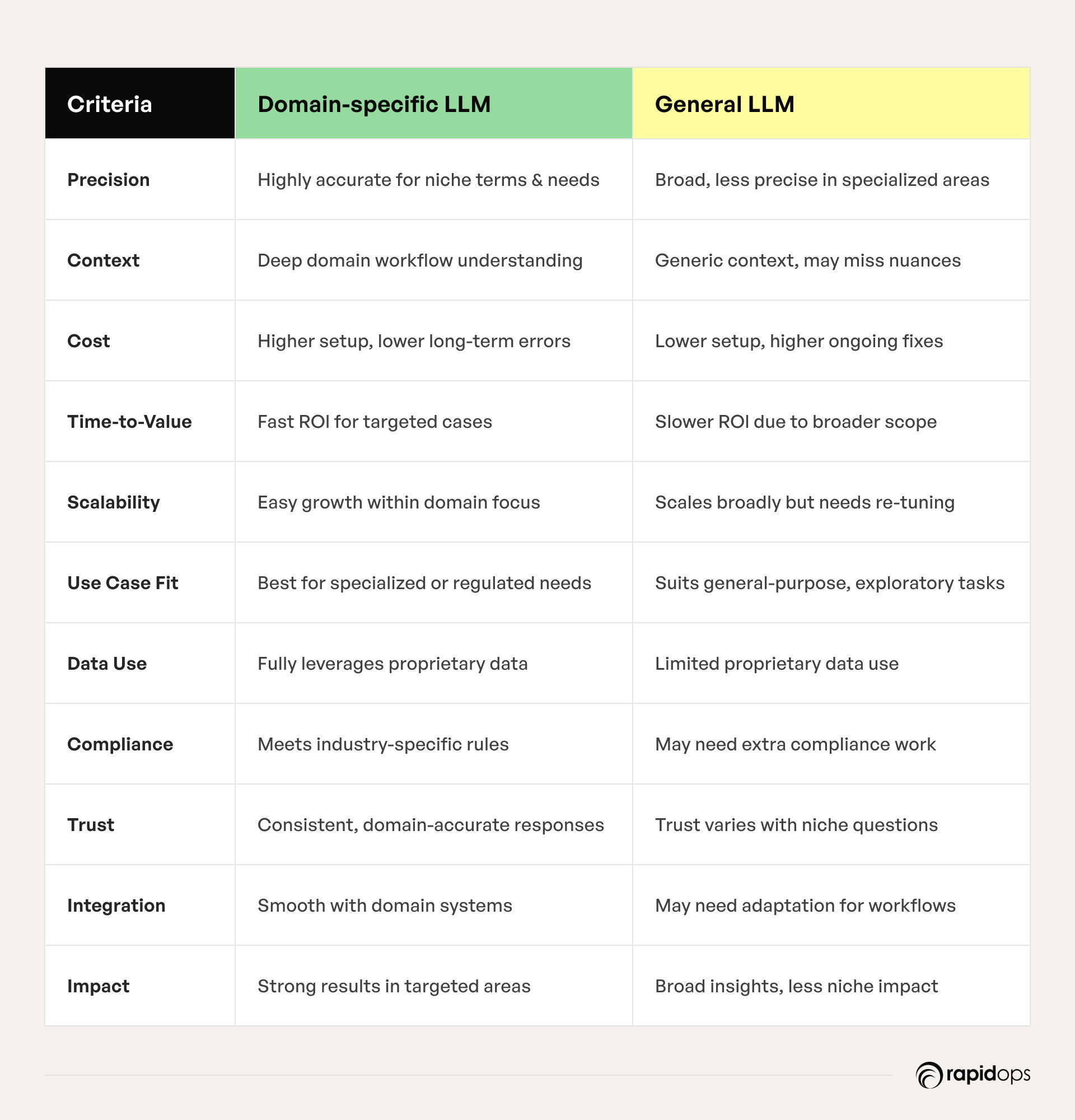
Precision and relevance
Domain-specific LLMs achieve superior precision by focusing on industry-tailored datasets, terminology, and workflows. This specialization ensures highly relevant outputs that reduce ambiguity and support complex decision-making. General LLMs, though versatile, may produce generic responses that lack the nuance required for specialized domains, potentially diluting actionable insights.
Contextual understanding
The strength of domain-specific LLMs lies in their deep grasp of sector-specific context, including regulatory language, operational procedures, and customer interactions unique to the industry. General models provide broad linguistic competence but often miss subtle domain nuances, limiting their effectiveness in regulated or specialized environments.
Cost and esource consideration
General LLMs offer quicker deployment with minimal customization, appealing for rapid prototyping or broad use cases. However, their lower domain accuracy can lead to increased manual oversight and hidden costs. Domain-specific LLM require upfront investment in curated training data and tailored integration but deliver cost efficiencies through reduced errors, automation, and enhanced alignment with enterprise workflows.
Use case suitability
General LLMs are well-suited for broad applications like customer service or generic content generation. In contrast, domain-specific LLMs excel in high-stakes environments such as healthcare diagnostics, financial risk modeling, or supply chain optimization, where precision and compliance are non-negotiable.
Data utilization
Domain-specific LLMs leverage proprietary and industry-specific datasets, transforming unique organizational knowledge into strategic assets. This enables more customized, precise AI outputs. General LLMs predominantly rely on publicly available data, limiting their ability to tailor insights to an organization’s unique context.
Risk and compliance
In regulated industries, domain-specific LLMs embed compliance frameworks into their training, proactively managing risks and reducing potential legal exposure. General models, lacking such specialization, may inadvertently generate non-compliant outputs, elevating operational and reputational risks.
User experience and trust
Reliable, context-aware responses from domain-specific LLMs foster greater user trust, accelerating adoption and broad organizational buy-in. General LLMs’ broader but less precise outputs can undermine confidence, slowing AI integration and limiting business impact.
Real-world Iimpact
Ultimately, domain-specific LLMs drive transformational business outcomes by tightly aligning AI capabilities with strategic priorities, compliance requirements, and operational realities. General LLMs serve as accessible entry points but may fall short in delivering sustainable competitive advantage in complex, domain-driven industries.
When should enterprises choose a domain-specific LLM
Enterprises face a critical choice in selecting language models that align with their unique business needs. Domain-specific large language models (LLMs) offer distinct advantages when precision, compliance, and contextual relevance are paramount. Choosing a domain-specific LLM becomes essential under several strategic conditions.
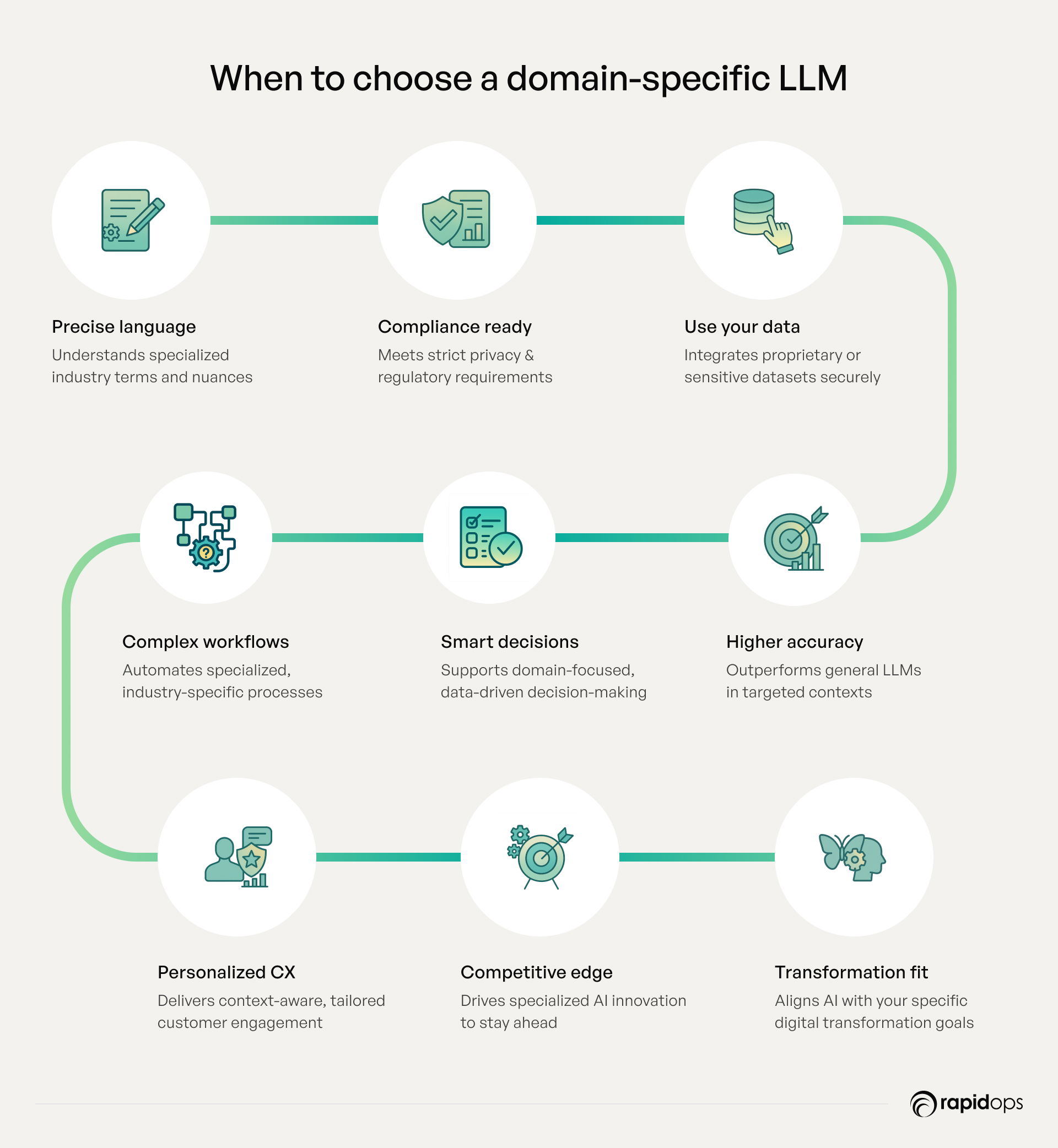
1. Need for precise industry-specific language understanding
Generic LLMs excel at broad language tasks but often struggle to grasp specialized terminology, jargon, or complex concepts unique to sectors such as healthcare, finance, manufacturing, or legal services. Domain-specific LLMs are trained on curated datasets from these industries, enabling superior comprehension and generation of highly accurate, relevant content that resonates with experts and clients alike.
2. Compliance and data privacy requirements
Regulated industries must adhere to stringent compliance frameworks (e.g., HIPAA, GDPR, FINRA). Domain-specific LLMs allow enterprises to embed compliance protocols and safeguard sensitive information by limiting exposure to public data sources. This control ensures data privacy and regulatory adherence while maintaining robust AI capabilities.
3. Integration of proprietary or sensitive data
Many enterprises rely on internal documents, proprietary knowledge bases, and sensitive customer data. Domain-specific LLMs can be fine-tuned or built to securely incorporate these datasets, enhancing AI insights while protecting intellectual property and confidential information.
4. Higher accuracy than general LLMs
In mission-critical scenarios, accuracy is non-negotiable. Domain-specific LLMs reduce ambiguity and errors by focusing on the context and nuances unique to their sector. This leads to improved outcomes in tasks such as contract analysis, medical diagnostics support, financial forecasting, or technical troubleshooting.
5. Domain-driven decision-making
Executives increasingly rely on AI to inform strategic decisions. Domain-specific LLMs deliver actionable intelligence aligned with industry realities, enabling faster, better-informed choices that drive competitive advantage and operational efficiency.
6. Automation of complex, industry-specific workflows
From claims processing in insurance to regulatory reporting in finance, domain-specific LLMs empower AI automation of intricate workflows that generic models cannot reliably execute. This improves productivity, reduces manual errors, and accelerates time-to-market.
7. Personalized, context-aware customer engagement
Delivering highly tailored experiences requires AI that understands the customer’s specific context and industry challenges. Domain-specific LLMs enable hyper-personalized interactions, boosting customer satisfaction, loyalty, and lifetime value.
8. Competitive pressure for specialized AI innovation
As AI adoption deepens, industry leaders differentiate by embedding specialized intelligence into products and services. Domain-specific LLMs are a critical enabler of innovation that addresses unique market demands faster and more effectively than broad-based models.
9. Alignment with tailored digital transformation goals
Digital transformation initiatives benefit from AI solutions aligned closely with organizational strategy and domain expertise. Domain-specific LLMs integrate seamlessly into industry workflows, amplifying transformation impact and delivering measurable business outcomes.
How domain-specific LLMs are built and customized
Building and customizing domain-specific large language models (LLMs) is a strategic process that transforms broad AI capabilities into precise, industry-tailored tools. This approach empowers enterprises to unlock actionable insights, improve operational efficiency, and maintain compliance in complex environments.
Base model pretraining on vast general data
The foundation of any domain-specific LLM is a robust base model, pretrained on extensive, diverse datasets. This broad training equips the model with fundamental language understanding and reasoning capabilities, forming a versatile platform ready for specialization.
Fine-uning with domain-specific datasets
Fine-tuning tailors the base model to industry-specific knowledge by training it on carefully curated domain datasets. These datasets capture unique terminology, jargon, workflows, and scenarios relevant to the sector, enhancing the model’s ability to generate precise, contextually relevant outputs.
Integration of proprietary and sensitive data
To maximize relevance and competitive advantage, domain-specific LLMs incorporate proprietary organizational data. This integration transforms exclusive internal knowledge into strategic AI assets, while ensuring data privacy and security protocols safeguard sensitive information throughout training and deployment.
Expert-guided training and validation
Domain experts play a critical role in supervising model training and validating outputs. Their input ensures that the LLM aligns with real-world practices, business requirements, and nuanced domain insights, significantly improving accuracy, reducing bias, and enhancing trustworthiness.
Embedding compliance and regulatory controls
Domain-specific LLMs embed regulatory frameworks and compliance controls within their training. This proactive approach enables models to recognize and adhere to industry standards, minimizing legal risks and ensuring that AI-driven decisions conform to evolving governance requirements.
Continuous learning and updates
Industries are dynamic, with evolving knowledge, regulations, and market conditions. Continuous learning pipelines enable domain-specific LLMs to stay current by regularly ingesting updated data and incorporating feedback, ensuring sustained relevance and high performance over time.
Custom deployment aligned with workflows
Successful domain-specific LLMs are deployed with custom configurations that seamlessly integrate into existing enterprise systems and workflows. This alignment optimizes user experience, maximizes operational efficiency, and accelerates adoption across business units.
This comprehensive process of building and customizing domain-specific LLMs enables organizations to transform AI from a generic technology into a powerful, precision-engineered asset delivering strategic business value, regulatory compliance, and competitive differentiation.
How do domain-specific LLMs pay off
Domain-specific LLMs, fine-tuned on industry data, deliver measurable returns. McKinsey reports retailers using these models can increase margins by 1.9 percentage points, equivalent to $240–$390 billion in economic value while generating faster, more accurate business decisions.
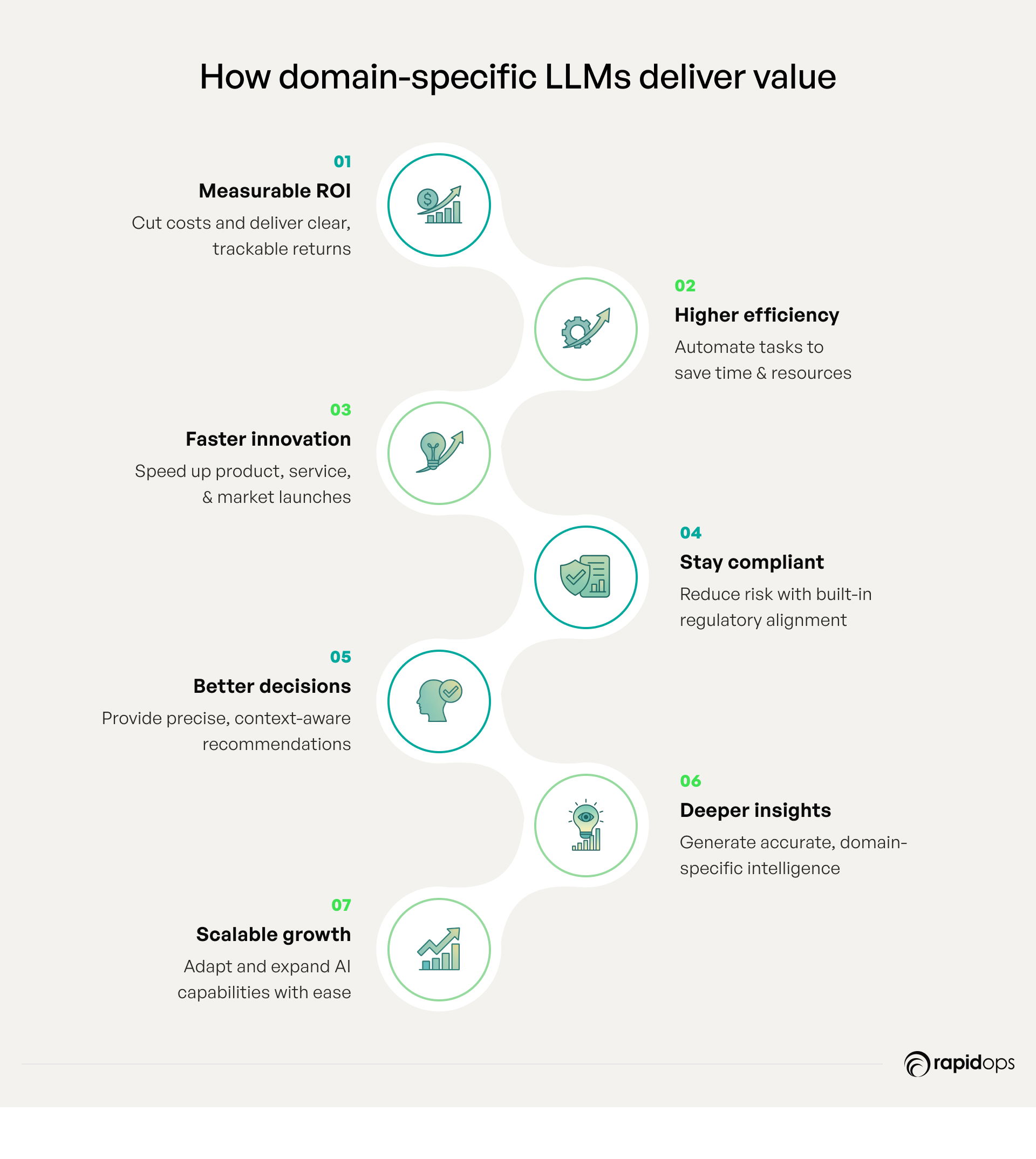
1. Deliver measurable ROI via cost savings
By automating complex, repetitive tasks such as customer support, compliance monitoring, and document review, domain-specific LLMs reduce reliance on manual labor and minimize errors. This automation cuts operational costs significantly, delivering a strong return on investment.
2. Boost efficiency through task automation
Domain-specific LLMs understand industry-specific terminology and business rules, enabling faster, more accurate execution of specialized workflows. This results in streamlined processes, higher productivity, and resources redirected to strategic priorities.
3. Enable faster innovation and market leadership
With deep domain expertise embedded, these LLMs accelerate AI software development services tailored to market needs. Enterprises gain agility to launch innovative products and services faster, securing competitive advantages and leadership positions.
3. Provide precise, context-aware decision support
Executives benefit from actionable insights grounded in domain context, improving the quality and confidence of strategic decisions. This context-awareness sharpens risk assessments, operational planning, and market responsiveness.
4. Accelerate accurate, domain-specific insights
These models extract nuanced information from complex datasets, enabling precise market analysis, customer behavior prediction, and competitive intelligence. This accuracy empowers timely and informed business responses.
5. Support scalable, adaptable AI growth
Domain-specific LLMs offer a flexible foundation that evolves with business needs. They can be continually fine-tuned with new data, maintaining relevance and performance while supporting enterprise-wide AI scaling.
6. Ensure regulatory compliance and risk reduction
Domain-specific LLMs incorporate up-to-date regulatory frameworks relevant to their sectors. This ensures outputs comply with data privacy laws and industry standards, reducing risk exposure, preventing fines, and strengthening stakeholder trust.
High impact use cases of domain-specific LLMs across the industry
Hyper-personalized experiences boost loyalty
When a customer asks about a product, a domain-specific LLM can instantly analyze their past purchases, browsing behavior, previous inquiries, and customer segment to provide a highly personalized response. For instance, it can recommend related products, suggest complementary items, or offer context-specific promotions tailored to that customer.
This real-time personalization extends across chatbots, email, and in-app messaging, ensuring consistent, relevant engagement at every touchpoint. By integrating with CRM and marketing platforms, the LLM can also predict potential churn, recommend next-best actions, and automate loyalty-focused interactions, enabling teams to focus on high-value tasks while driving higher retention, increased conversions, and sustainable growth.
Accurate demand forecasting and inventory optimization
Fluctuating customer demand can disrupt supply chains, causing excess stock or missed sales. A domain-specific LLM continuously evaluates historical purchases, seasonal trends, promotional effects, and market signals to forecast demand with precision. For instance, if demand spikes for a specific product in a region, the system can proactively suggest inventory adjustments, reallocation between warehouses, or timely replenishment, reducing the risk of stockouts or overstock.
Connected to ERP and supply chain systems, the LLM provides real-time recommendations for procurement, production, and distribution teams. This enables operations to remain agile, minimize working capital, and ensure products are available when and where customers need them. The outcome is a streamlined, responsive supply chain that enhances efficiency and delivers measurable business value.
Predictive maintenance reducing downtime in manufacturing
Unexpected equipment failures disrupt production and inflate costs. Domain-specific LLMs continuously analyze sensor readings, machine performance logs, and operational parameters to detect early signs of wear or malfunction. For instance, if a motor shows unusual vibration or a pump’s temperature rises, the system can alert teams, recommend inspections, or schedule preventive maintenance before failure occurs. By integrating with maintenance platforms, these models enable proactive, real-time decisions, reduce downtime, extend asset life, and enhance operational efficiency, turning AI into a strategic partner for manufacturing operations.
Automated quality assurance and early defect detection
Maintaining high product quality at scale is a persistent challenge. Domain-specific LLMs continuously analyze sensor data, machine readings, and visual inspection outputs to detect defects as soon as they appear. For example, if a component shows micro-fractures or deviations in dimensions, the system can alert production teams, trigger immediate adjustments, or halt the line to prevent defective output. Integrated with quality management systems, this proactive approach reduces waste, scrap, and rework, ensures regulatory compliance, and strengthens brand reputation by consistently delivering flawless products.
Precision supply chain planning and inventory allocation
Balancing cost, service levels, and inventory efficiency is a major supply chain challenge. Domain-specific LLMs analyze supplier reliability, historical demand, logistics constraints, and market factors to provide actionable recommendations for inventory allocation and replenishment. For example, if a key supplier shows potential delays or demand spikes in a region, the system can suggest inventory redistribution, adjust safety stock, or optimize delivery schedules. By integrating with ERP and planning platforms, these insights enable agile, resilient supply chains, reduce stockouts or overstock, and support sustained business growth.
How to implement a domain-specific LLM in your enterprise
Implementing a domain-specific large language model (LLM) is a transformative initiative that can unlock unprecedented business value. Success hinges on a disciplined, strategic approach that integrates technology, data, governance, and operational alignment. Here’s a step-by-step guide designed for senior leaders to drive effective LLM adoption.
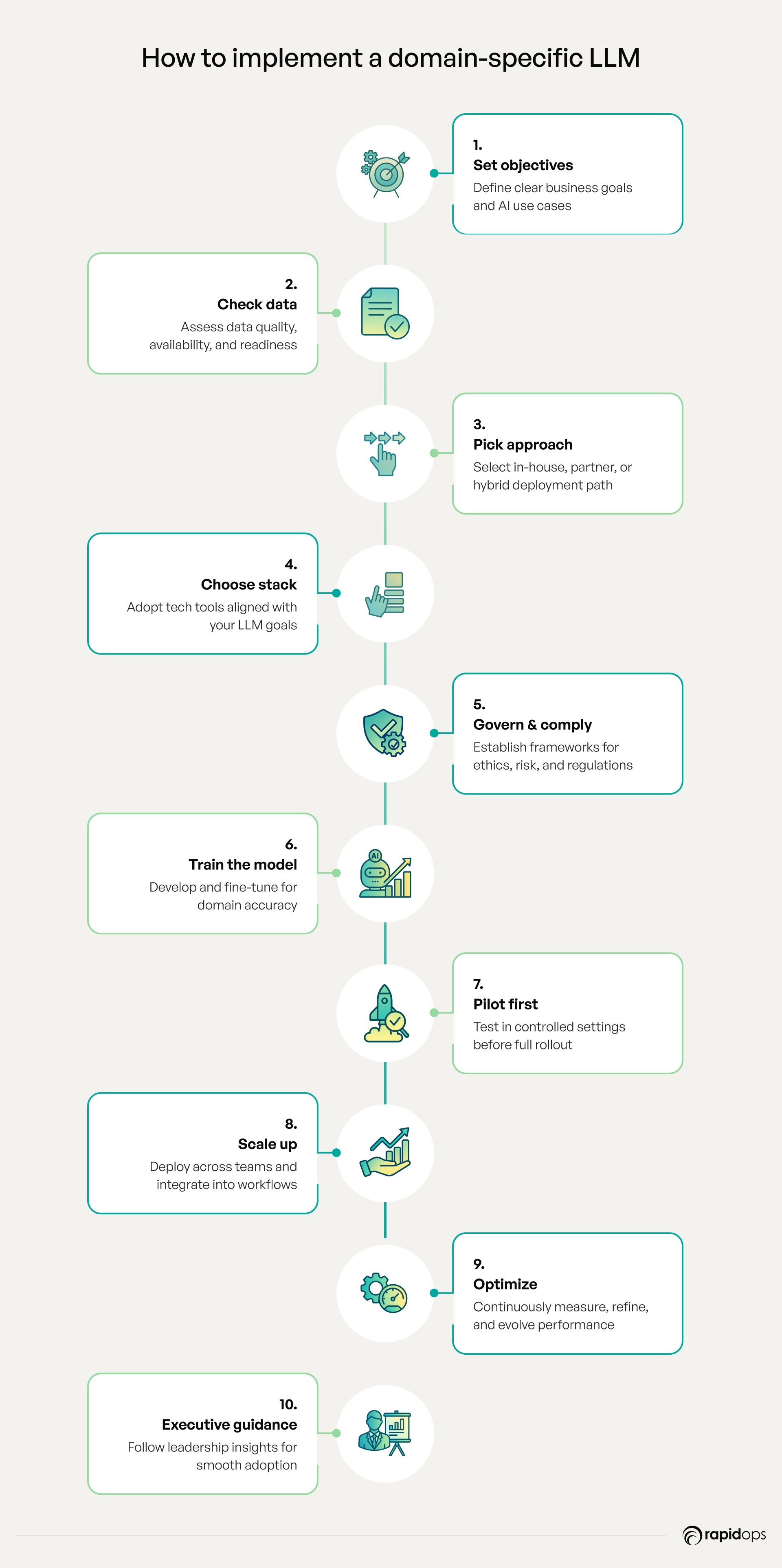
1. Define strategic objectives
Begin by clearly defining the strategic goals your domain-specific LLM will achieve. Align the initiative with core business priorities whether improving decision accuracy, accelerating operational workflows, enhancing customer experiences, or ensuring regulatory compliance. A well-articulated objective ensures all stakeholders share a unified vision and that the LLM’s capabilities translate into measurable business impact.
2. Assess data readiness
Evaluate your organization’s data landscape to ensure access to high-quality, domain-relevant datasets. Assess data completeness, accuracy, and sensitivity, including proprietary and regulated information. Robust data readiness is critical, as the quality of training data directly influences model performance and reliability. Additionally, ensure data governance protocols safeguard privacy and comply with industry standards.
3. Select the implementation approach
Choose the right implementation model based on your organization’s technology maturity, resource availability, and timeline. Options range from fully in-house development, partnering with specialized vendors, or hybrid approaches combining both. Each has trade-offs in control, speed, and cost, select the path that best balances your enterprise’s strategic needs and operational capabilities.
4. Build governance and compliance frameworks
Establish comprehensive governance structures that embed compliance, ethical AI principles, and risk management into the LLM lifecycle. This framework must cover data privacy, regulatory adherence, auditability, and transparency. Proactive governance mitigates legal and reputational risks while fostering stakeholder confidence in AI-driven decisions.
5. Develop and train the model
Leverage curated domain datasets, enriched with proprietary organizational data, to fine-tune your LLM for maximum precision and contextual relevance. Incorporate expert validation throughout training to reduce biases and ensure outputs reflect real-world domain knowledge. This step transforms a generic language model into a trusted, domain-savvy AI asset.
6. Pilot and test in controlled environments
Before broad deployment, conduct rigorous pilots within controlled settings. Validate the LLM’s accuracy, user experience, integration robustness, and compliance adherence. Piloting uncovers operational gaps, surface risks early, and builds user trust by demonstrating tangible value.
7. Deploy at scale
Following successful validation, deploy the domain-specific LLM across relevant business units. Ensure seamless integration with existing enterprise systems and workflows to maximize adoption and operational efficiency. Scalable deployment enables consistent AI-powered decision-making at the enterprise level.
8. Measure, optimize, and evolve
AI is not a one-time project but an ongoing journey. Continuously monitor performance metrics, user feedback, and business outcomes to optimize model effectiveness. Establish feedback loops and update mechanisms that allow your domain-specific LLM to evolve with changing data, regulations, and market dynamics, sustaining long-term value.
Key challenges of domain-specific LLM implementation
Implementing domain-specific LLMs can transform enterprises but comes with key challenges. Business leaders need clear insight into these complexities to make smart investment and implementation decisions.
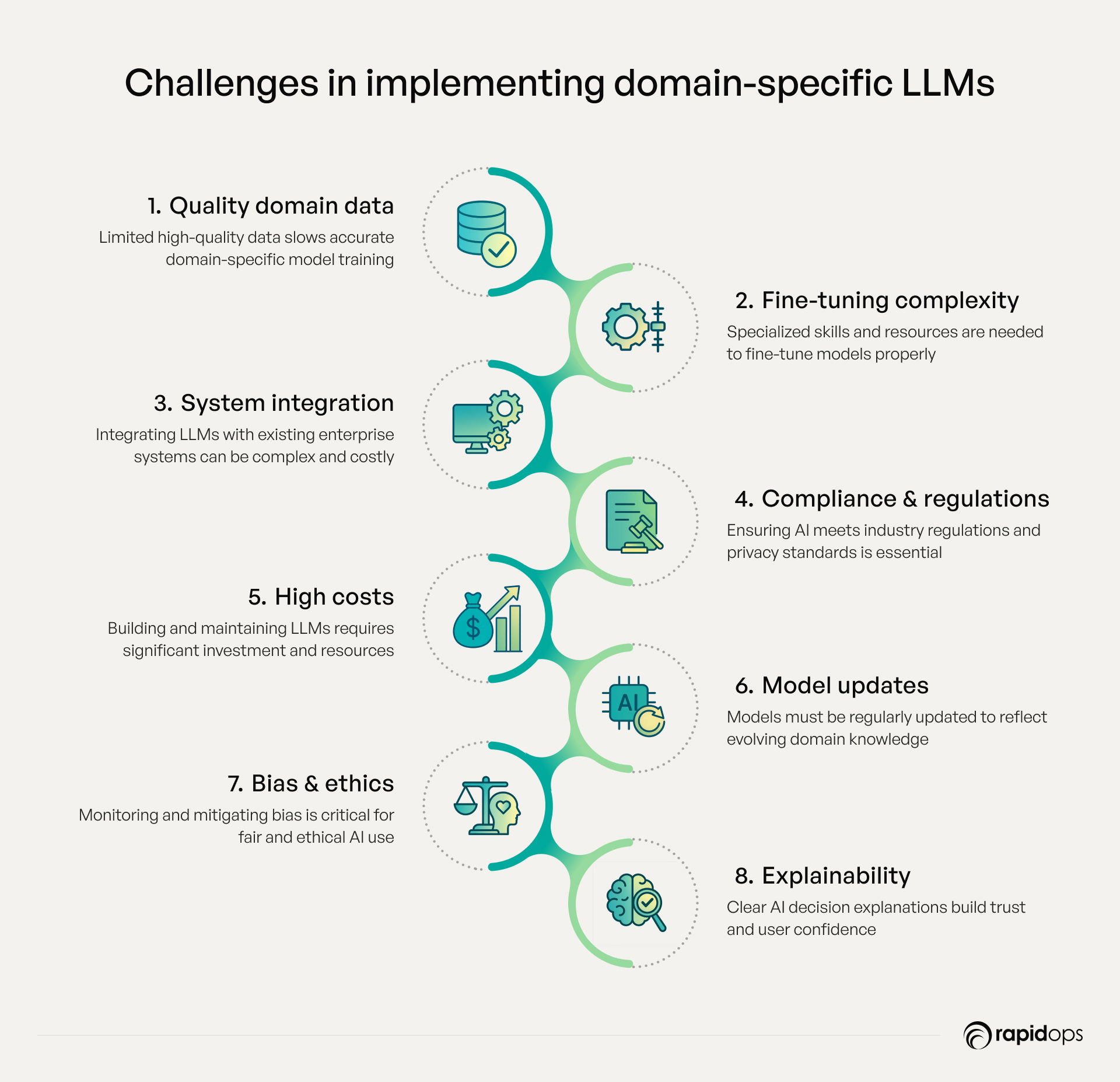
Limited availability of quality domain data
High-quality, relevant domain data is the cornerstone of effective LLM training. Many industries face scarcity of clean, labeled, and comprehensive datasets specific to their unique terminology, workflows, and contexts. Without sufficient quality data, fine-tuning models risks underperformance and limited accuracy.
Technical complexity of fine-tuning
Adapting a general LLM to domain-specific needs requires advanced technical expertise. LLM Fine-tuning involves not just model training but also architecture adjustments, hyperparameter optimization, and continuous validation. Enterprises often need specialized AI talent and infrastructure to manage this complexity effectively.
Integration with existing enterprise systems
Domain-specific LLMs must seamlessly integrate with legacy platforms, databases, and business applications. This integration is often complicated by disparate data formats, security protocols, and operational workflows, requiring careful orchestration to avoid disruption and maximize synergy.
High costs and resource demands
Developing, deploying, and maintaining domain-specific LLMs involve significant investment in computing resources, data acquisition, expert personnel, and ongoing support. Cost-benefit analysis must weigh these investments against expected efficiency gains and strategic outcomes.
Keeping models updated with evolving knowledge
Industries evolve rapidly, and models must reflect the latest domain knowledge to remain effective. Continuous retraining and dataset updates are required to keep pace with regulatory changes, market trends, and emerging terminology.
Managing bias and ethical risks
Domain-specific LLMs can inadvertently perpetuate biases present in training data, impacting fairness and decision quality. Enterprises must implement bias detection, mitigation strategies, and ethical guidelines to maintain trust and accountability.
Ensuring explainability and transparency
For critical applications, especially in regulated industries, understanding how LLMs arrive at decisions is essential. Enterprises must prioritize model explainability to satisfy compliance, enable auditing, and support user trust.
Scaling deployment across business units
Extending domain-specific LLM capabilities beyond pilot projects to enterprise-wide deployment poses organizational and technical challenges. Standardizing processes, ensuring consistent data quality, and managing cross-unit collaboration are vital for scalable success.
Tailored intelligence that understands you
What you’ve uncovered about domain-specific LLMs is more than technology; it’s a profound shift in how your business can harness AI to understand and address the unique complexities of your industry. These models deliver tailored intelligence that goes beyond generic insights, empowering you to make decisions with clarity and confidence in a rapidly evolving landscape. We know the weight of these decisions and the impact they carry.
At Rapidops, we bring deep, hands-on experience in training and deploying domain-specific LLM services across diverse industries. Our expertise isn’t just technical, it’s rooted in solving real-world challenges like data complexity, and operational scale. Together, we co-create AI strategies that align with your vision and unlock measurable impact.
Ready to explore what domain-specific LLMs can truly do for your business?
Schedule a session with our domain-specific LLMs expert, who will show you exactly how to harness domain-specific LLMs within your business to uncover actionable opportunities and deliver measurable results.
Frequently Asked Questions
Which industries benefit the most from domain-specific LLMs?
Industries with complex, structured, and regulated data such as retail, manufacturing, and distribution, derive the highest value. Tailored LLMs provide actionable insights, optimize operations, and enhance customer engagement, creating measurable competitive advantage.
How do domain-specific LLMs improve decision-making?
By leveraging industry-specific datasets and operational knowledge, these models generate precise, context-aware recommendations. They reduce ambiguity, accelerate analysis, and enable leaders to make informed decisions faster, aligning operational outcomes with strategic goals.
What types of data are used to train domain-specific LLMs?
Domain-specific LLMs are trained on proprietary organizational data, industry benchmarks, regulatory documentation, transactional records, and customer interaction datasets. This ensures the model understands sector-specific terminology, workflows, and decision-making nuances.
How long does it take to deploy a domain-specific LLM?
Deployment timelines vary based on complexity, data availability, and business integration requirements. Typically, initial fine-tuning and pilot deployment can take 8–16 weeks, while full-scale enterprise adoption may span 4–6 months with proper infrastructure and governance.
Can existing LLMs be adapted into domain-specific LLMs?
Yes. Pre-trained general LLMs can be fine-tuned with domain-specific data, enabling organizations to leverage existing capabilities while rapidly aligning the model to industry contexts, reducing development time and cost compared with building from scratch.
How do domain-specific LLMs integrate with existing enterprise systems?
These models are designed to interface with ERP, CRM, analytics platforms, and other enterprise systems via APIs and modular architectures. Integration ensures seamless data flow, enhances workflow automation, and embeds AI-driven insights directly into operational processes.
What is the difference between fine-tuning and full training of domain-specific LLMs?
Fine-tuning adjusts an existing LLM with domain-specific data, enabling faster, cost-effective specialization. Full training builds a model from scratch using domain datasets, offering maximum control and customization but requiring greater resources, time, and expertise.

Rahul Chaudhary
Content Writer
With 5 years of experience in AI, software, and digital transformation, I’m passionate about making complex concepts easy to understand and apply. I create content that speaks to business leaders, offering practical, data-driven solutions that help you tackle real challenges and make informed decisions that drive growth.
What’s Inside
- From generic LLMs to domain-specific intelligence
- Understanding domain-specific LLMs
- How general LLMs Work
- Why generic LLMs alone aren’t enough
- Why do you need to tailor your LLM to be domain-specific?
- Domain-specific vs general LLM
- When should enterprises choose a domain-specific LLM
- How domain-specific LLMs are built and customized
- How do domain-specific LLMs pay off
- High impact use cases of domain-specific LLMs across the industry
- How to implement a domain-specific LLM in your enterprise
- Key challenges of domain-specific LLM implementation
- Tailored intelligence that understands you

Let’s build the next big thing!
Share your ideas and vision with us to explore your digital opportunities
Similar Stories
- AI
- 4 Mins
- September 2022

- AI
- 9 Mins
- January 2023


Receive articles like this in your mailbox
Sign up to get weekly insights & inspiration in your inbox.

